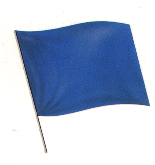Water Source—Potential Impact Flags
Now that you have mapped your watershed, you can set up an inventory of potential impacts that may affect the health of the watershed. We will refer to the areas that show a possible sensitivity to the watershed as flags. If the area of sensitivity covers the whole watershed, the flag is referred to as a regional flag.
 Flag colors denote the base overlays they come from: white for land use, yellow for landscape, blue for water pathways and storage, and green for plant and animal communities.
Flag colors denote the base overlays they come from: white for land use, yellow for landscape, blue for water pathways and storage, and green for plant and animal communities.
White Flag
Use white flags for areas in the region that are historically important, such as burial grounds and archaeological or historic areas.
Yellow Flag
Use yellow flags for areas of unusual geological features, such as fossil outcrops, unique canyons, escarpments, glacial features, etc.
Blue Flag
Blue flags are for areas where more than 5% of the shorelines are hardened or straightened. Also place a blue flag if there is more than one dam in the area or a well with undrinkable water.
Green Flag
Place a green flag if less than 70% of the shorelines are naturally vegetated. Also place a green flag in any area where point-source interference is happening, such as aggressive agriculture or major draining of areas, or near shore habitat altering or the closing of transport corridors, which shut off migration areas.
Examining Plans
Create an overlay to show conflict between uses of the land and the plans for the area. Check to see if what is stated is what is really happening out there. Some resources are out of date and might not give an accurate picture of what is going on in the area in question.
This content has been re-published with permission from SEED. Copyright © 2025 Schlumberger Excellence in Education Development (SEED), Inc.

